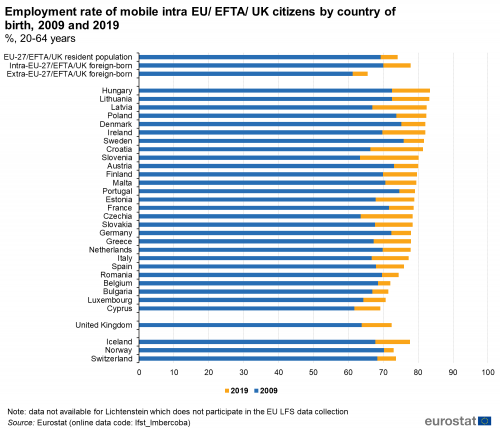Archive:EU and EFTA born population living in another EU or EFTA country - statistical overview
Data extracted in June 2020.
Planned article update: July 2021.
Highlights
EU-28/EFTA foreign-born population by origin, 2008-2018
This article looks at the size, composition and labour market situation of the foreign-born population of working age (from 20 to 64) residing within the EU-27, the EFTA and the United Kingdom (UK), by their country of birth. The analysis addresses separately foreign-born people with origins in an EU-27/EFTA/UK country (‘intra-EU-27/EFTA/UK foreign-born population’) and those from other countries. It then compares these two broad categories with each other and with the EU-27/EFTA/UK native-born population (i.e. people born in an EU-27/EFTA country or the UK who reside in their country of birth).
While intra-EU-27/EFTA/UK mobility (i.e. the movement within the EU-27, EFTA territories and the UK of people born in an EU-27/EFTA/UK country) is analysed by country of birth, extra-EU27/EFTA/UK foreign-born population (i.e. those residing in an EU-27/EFTA country or the UK but born outside them) is analysed solely as a single group without any breakdown by country of birth. This is because of quality constraints, for example because the small sample sizes make it difficult to obtain reliable estimates. The analysis is based on European Union — Labour Force Survey (EU-LFS) data and covers the period between 2009 and 2019.
Full article
Overview
In 2019, almost 5 out of every 100 people of working age (20-64) born in an EU-27/EFTA country or the UK resided in an EU-27/EFTA country or the UK other than their country of birth (4.9 %). This corresponds to an increase of 1.4 percentage points compared to 2009 (3.5 %).
On average, over the whole decade, about 35 % of the total EU-27/EFTA/UK foreign-born population were born in an EU-27/EFTA country or the UK, while the remaining 65 % were born elsewhere in the world.
Over the decade, Romanian-born and Polish-born were the two most numerous intra-EU-27/EFTA/UK foreign-born groups. In 2019, they accounted for 19.4 % and 16.7 % respectively of the total intra-EU-27/EFTA/UK foreign-born population.
In 2019, 36.1 % (about 5.7 million) of the 15.9 million intra-EU-27/EFTA/UK foreign-born population of working age were tertiary graduates, compared with 30.0 % of the third-country foreign-born population and 32.2 % of the native-born population residing within the EU-27, EFTA or UK.
The overall employment rate of the intra-EU-27/EFTA/UK foreign-born population is significantly higher than among the third-country foreign-born population. This also holds true when comparing with employment rates of EU-27, EFTA and UK citizens that reside in their country of birth.
The difference in the employment rate between Greek-born people residing in an EU-27/EFTA/UK country other than Greece and the Greek-resident population stood at +16.7 percentage points (pp), the biggest difference recorded among intra-EU-27/EFTA/UK foreign-born groups.
Foreign-born people originating in third countries were much less likely to be in employment than those originating in the EU-27/EFTA/UK, chiefly because the average 55.9 % employment rate among foreign-born (outside of the EU/EFTA/UK) women was 15.6 pp lower than that of women originating in an EU-27/EFTA country or the UK.
Between 2009 and 2019, there was a general slight narrowing of the gender gap in the employment rate except for extra-EU-27/EFTA/UK born group.
Foreign-born population residing within the EU-27, EFTA and the UK - changes over time
In 2019, the foreign-born population of working age (20-64) residing in the EU-27/EFTA/UK country accounted for 14.8 % of the total population of these countries, which was 4.3 pp more than a decade ago. In absolute terms, it increased 1.4 times from more than 32 million people in 2009 to more than 45 million in 2019. Looking at their origin, over the decade, the movement within the EU-27, EFTA and UK of people born in the EU-27/EFTA/UK had similar intensity than of people born outside these countries. As a result, in 2019 almost 16 million people born in an EU-27/EFTA country or the UK were residing in the EU-27/EFTA/UK other than their country of birth, which means 1.4 times more than in 2009. They represented almost 4.9 % of the total EU-27/ EFTA/ UK resident population in 2019 compared with 3.5 % in 2009. In 2019, 9.7 % of the EU-27/EFTA/UK resident population, or almost 30 million people, had been born outside the EU-27, EFTA or UK, up from more than 21 million in 2009. On average, in 2019 about 35 % of the EU-27/EFTA/UK foreign-born population were born in an EU-27/EFTA country or the UK, while the remaining 65 % were born elsewhere.
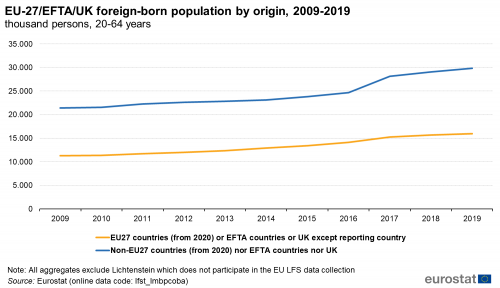
Source: Eurostat (lfst_lmbpcoba)
Figure 2 shows the intra-EU-27/EFTA/UK foreign-born population as a share of the total EU-27/EFTA/UK resident population born in the EU-27/EFTA/UK. In 2019, almost 5 out of every 100 people aged 20-64 born within the EU-27/EFTA/UK resided in the EU-27/EFTA/UK other than their country of birth (4.9 %). This corresponds to an increase of 1.4 percentage points compared to 2009 when it was 3.5 %.

Source: Eurostat (lfst_lmbpcoba)
EU-27/EFTA/UK foreign-born population - from which countries?
Breaking down the intra-EU-27/EFTA/UK foreign-born population shows that in 2019, Romanian-born and Polish-born accounted for 19.4% and 16.7 % respectively of the total intra-EU-27/EFTA/UK foreign-born population. This makes them by far the two largest foreign-born groups originating in the EU-27/EFTA/UK residing outside their country of birth, with both groups together accounting for more than a third of the total intra-EU-27/EFTA/UK foreign-born population. German-born came third with 8.6 % and Italian-born and Portuguese-born were the next two foreign-born groups residing outside their country of birth, with 6.6 % and 6.2% respectively. Together, these five groups represented over half the intra-EU-27/EFTA/UK foreign-born population in 2019 (57.5 %).
However, while German-born accounted for 3.4 % of the German native-born population residing in the EU-27/EFTA/UK country (including Germany), their Romanian-born peers accounted for more than a fifth (20.9 %) of the Romanian native-born population residing in the EU-27/EFTA/UK country (Romania included).
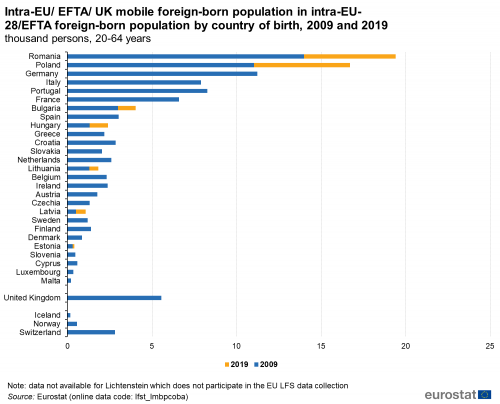
Source: Eurostat (lfst_lmbpcoba)
In 2019, at least 1 in 5 Romanian-born people residing in the EU-27/EFTA/UK did not reside in Romania. The same was true for the Luxembourg-born group (i.e. about 1 in 5 Luxembourg-born people residing in the EU-27/EFTA/UK did not reside in Luxembourg). By comparison, in 2009 about 1 in 10 Romanian-born residing within the EU-27/EFTA/UK resided in the EU-27/EFTA/UK other than Romania: this group recorded the biggest increase in share of natives residing within the EU-27/EFTA/UK but outside their country of birth (+10.5 pp). This share can be seen as a good measurement of emigration, except for Luxembourg which is a special case in this context. For instance, in 2014 (the last reference year for which breakdown by generation is available), only 32.0 % of Luxembourg’s residents were native-born, while in all other EU-27/EFTA countries and the UK at least 67 % of the resident population is native-born (see ‘First and second-generation immigrants — statistics on main characteristics’, Table 1). This indicates that a large proportion of people born in Luxembourg actually do not move to another country but possibly return back to their parents’ country of birth or move to other countries as this category tends to be more mobile. It cannot be estimated how large this phenomenon is, but it is clearly significant as such and in comparison with other EU-27/EFTA countries and the UK. The top five biggest foreign-born groups by share of natives residing within the EU-27/EFTA/UK but outside their country of birth is completed by Portuguese-born (15.5 %), Lithuanian-born (15.4 %) and Latvian-born (14.4 %).
The second-largest foreign-born group by increase in the share of natives residing within the EU-27/EFTA/UK but outside their country of birth was Latvian-born people, which increased by 9.7 pp. By contrast, the biggest decrease was recorded among Cypriot-born people (from at least 1 in every 7 people in 2009 to 1 in every 9 in 2019, i.e. -3.7 pp).
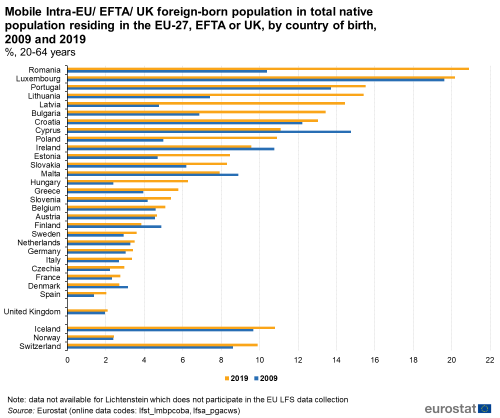
Source: Eurostat (lfsa_pgacws)
Top origin countries - compared to a decade ago
Between 2009 and 2019, Romanian-born and Polish-born were the two largest native groups in terms of absolute growth of those residing within the EU-27/ EFTA/UK but outside of their country of birth. Romanian-born increased by 1.5 million people, from almost 1.6 million in 2009 to almost 3.1 million in 2019. The absolute increase over this period for Polish-born was 1.4 million people, from 1.2 million to 2.6 million.
The foreign-born population originating in 8 other countries increased by at least 100 000 people in 2019 compared with 2009: Bulgarian-born (305 000 people), Hungarian-born (233 600 people), Italian-born (159 800 people), French-born (145 100 people), Lithuanian-born (143 600 people), Spanish-born (138 500 people), Latvian-born (114 800 people) and German-born (105 700 people).
By contrast, the intra-EU-27/EFTA/UK foreign-born population originating from 6 out of the 31 EU-27/EFTA countries and the UK decreased over the decade in absolute terms: Ireland (-43 500 people), Finland (-42 100 people), Cyprus (-16 900 people), Denmark (-15 900 people), Malta (-3 200 people) and Norway (-1 500 people).

Source: Eurostat (lfst_lmbpcoba)
EU27/EFTA/UK foreign-born population - educational level
In 2019, 36.1 % (about 5.7 million) of the 15.7 million intra-EU-27/EFTA/UK foreign-born population of working age were tertiary graduates, compared with 30.0 % of third-country foreign-born and 32.2 % of the EU-27/EFTA/UK native-born population. The trend over time indicates an increase in the level of educational attainment level among the intra-EU-27/EFTA/UK foreign-born population: it gradually increased from 27.1 % in 2009 to 36.1 % in 2019, while the corresponding share of people with a primary education level declined from 29.0 % in 2009 to 22.0 % in 2019. Secondary education is still the most common level of educational attainment among the intra-EU27/EFTA/UK foreign-born population, with a share remaining approximately stable over the decade, dipping to 41.5 % in 2016 and peaking at 44.1 % in 2010.

Source: Eurostat (lfst_lmbpcobed)
Comparing the share of people with tertiary education among the three broad population categories analysed in this article shows that the highest proportion is observed among the intra-EU-27/EFTA/UK foreign-born population. Throughout the decade, the proportion of highly educated people was very similar among the third-country foreign-born and the EU-27/EFTA/UK native-born populations. All three broad categories followed the same trend, ascending with approximately the same coefficient.
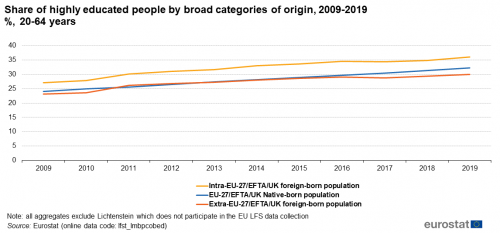
Source: Eurostat (lfst_lmbpcobed)
EU27/EFTA/UK foreign-born population - employment rate
Figure 8 shows that, between 2009 and 2019, the intra-EU-27/EFTA/UK foreign-born population had better labour market outcomes than the extra-EU-27/EFTA/UK foreign-born population, as 77.8 % of them were in some form of employment as compared with only 65.5 % for the latter group. The overall employment rate of the third-country foreign-born population was lower than that of any other foreign-born group originating in an EU-27/EFTA country or in the UK. For 19 out of the 31 EU-27/EFTA countries and the UK, the employment rates in 2019 of their native-born populations residing in the EU-27/EFTA/UK other than their country of birth exceeded that of the intra-EU-27/EFTA/UK foreign-born population as a whole. At least four fifths of Hungarian-born, Lithuanian-born, Latvian-born, Polish-born, Danish-born, Irish-born, Swedish-born, Croatian-born, Slovenian-born and Austrian-born groups residing in the EU-27/EFTA/UK other than their country of birth was in some form of employment in 2019.
The largest increase in the employment rate among intra-EU-27/EFTA/UK foreign-born groups was recorded for Slovenian-born people, increasing from 63.3 % in 2009 to 80.1 % in 2019 (+16.8 pp). This was followed by the rate among Latvian-born, which increased from 66.9 % to 82.4 % (+15.5 pp) and Croatian-born which increased from 66.9 % to 81.4 % (+15.1 pp). By contrast, the smallest increase in employment rate was recorded among the Belgian-born population residing in an EU-27/EFTA country or the UK other than Belgium (from 68.5% in 2009 to 72.0 % in 2019).
Figure 9 compares, by country of birth, the employment rate of intra-EU-27/EFTA/UK foreign-born groups with the employment rate of the resident population of their country of birth. In 19 of the 31 EU-27, EFTA countries and the UK, the employment rates of people residing outside their country of birth was higher than of those residing in their own country of birth. The differences were significant among the Greek-born (+16.7 pp), Croatian-born (+14.7 pp) and Italian-born (+13.8 pp) populations living abroad in the EU-27/EFTA/UK. By contrast, the employment rate of the foreign-born population is at least 5 pp less than that of the population residing in their country of birth among the Swiss-born (-9.3 pp), Icelandic-born (-8.3 pp), British-born (-6.9 pp), Cypriot-born (-6.6 pp) and Norwegian-born (-6.5 pp).
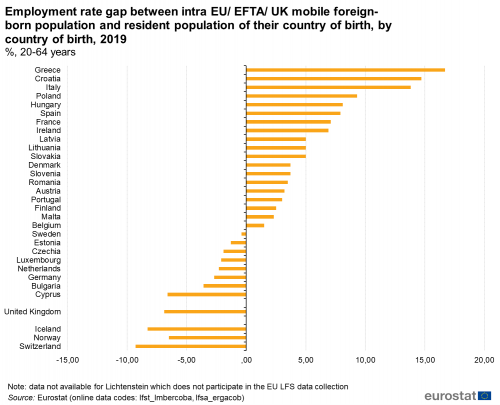
Source: Eurostat (lfst_lmbercoba) and (lfsa_ergacob)
Over the decade, the employment intensity of the EU-27/EFTA/UK foreign-born population varied. As illustrated in Figure 10, the third-country foreign-born population systematically recorded lower employment rates than the foreign-born population originating in an EU-27/EFTA country or the UK. The trend was also different: the employment rate among the intra-EU-27/EFTA/UK foreign-born population increased slightly over time (except between 2009 and 2010). By contrast, the employment rate among the third-country foreign-born population decreased between 2009 and 2013. However, the employment rate among the third-country foreign-born population picked up in 2014-2019, exceeding the initial 2009 level (65.5 % in 2019 compared with 61.2 % in 2009).
Changes in the employment rate of the intra-EU-27/EFTA/UK foreign-born population and their peers residing in their country of birth were similar. Both rates increased (except between 2009 and 2010), although slightly more among the intra-EU-27/EFTA/UK foreign-born population. Thus, the gap between the intra-EU-27/EFTA/UK foreign-born and the corresponding intra-EU-27/EFTA/UK native-population gradually increased from 0.2 pp in 2009 to 3.0 pp in 2019 (in favour of the intra-EU-27/EFTA/UK foreign-born).
EU-27/EFTA/UK foreign-born population - gender employment gap
Despite policy initiatives of national governments and the European Commission promoting women’s participation on the labour market, gender inequalities persist. Looking at the gender breakdown of EU-27/EFTA/UK-level employment rates by origin in 2019, the highest employment rate (84.5 %) was recorded among the male foreign-born population originating in an EU-27/EFTA country or the UK, which was +13.0 pp more than the corresponding rate of their female peers. By contrast, the foreign-born female population originating in a third country recorded the lowest employment rate (55.9 %), with the largest gender gap (-19.8 pp). Thus, foreign-born people originating in third countries were much less likely to be in employment than those originating in the EU-27/EFTA/UK. This is chiefly because the average employment rate of 55.9 % among women was 15.6 pp lower than that of their female peers from an EU-27/EFTA country or the UK. The male employment rate of the EU-27/EFTA resident population was in between (79.7 %), with the smallest gender gap (+11.3 pp). Overall, the employment rates for women were significantly lower than those of men, irrespective of their origin.

Source: Eurostat (lfst_lmbercobg)
Between 2009 and 2019 there was a general narrowing of the gender gap within the employment rate for all broad groups by origin, except for the extra-EU-27/EFTA/UK born population. The highest relative reduction in the gender gap was registered among EU-27/EFTA/UK residents (-2.8 pp) followed by foreign-born originating in the EU-27/EFTA/UK (-1.9 pp) whereas for those originating in third-countries it increased slightly (1.6 pp).
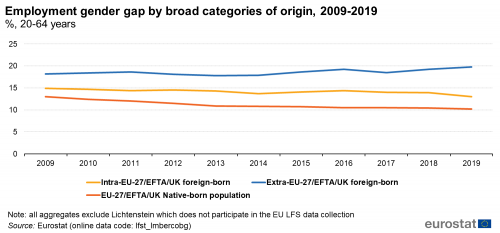
Source: Eurostat (lfst_lmbercobg)
Source data for tables and graphs
Data sources
The section Labour mobility provides demographical and labour statistics on people of working age (20-64) either born in the European Union (EU), the European Free Trade Association (EFTA) or the UK area or having the citizenship of an EU/EFTA country or the UK and residing elsewhere on the EU/ EFTA/UK territories except their country of birth/citizenship. This implies a new “emigration” (country of origin) perspective, as the estimates coming from the Labour Force Survey (EU-LFS) of all EU/EFTA countries and the UK, except that of origin or nationality, are aggregated in order to find all the persons of a certain nationality or country of origin that reside elsewhere where the EU rules regarding the free movement of people apply. On the other hand, they can be effectively identified only if a change of residence implying crossing a border has taken place, meaning they reside (or intend to do so) in another country for at least 12 months. Short term movements are therefore not taken into account.
The reference population is the European Union, the EFTA countries and the UK except Lichtenstein which does not participate in the EU LFS data collection. The analysis is restricted to the working age population 20-64, in order to limit as much as possible the impact of those who are not (yet/ any longer) active on the labour market and are more likely to be abroad for studying (or retirement) rather than employment reasons.
Concepts (some created/adapted for the purpose of this article):
- ‘foreign-born’ refers to any person born in a country other than their country of residence and whose residence period in the host country is, or is expected to be, at least 12 months
- ‘intra-EU-27/EFTA/UK foreign-born population’ is the total number of foreign-born people who both reside and were born within the EU-27, EFTA territories and the UK.
- ‘third-country foreign-born population’ or ‘extra-EU-27/EFTA/UK foreign-born population’ refers to the total number of foreign-born people residing within the EU-27, EFTA and UK but born outside them.
- ‘native-born’ refers to any person born in their country of residence
- ‘EU-27/EFTA/UK native-born population’ refers to the total number of people born in an EU-27/EFTA country or the UK and residing in their country of birth
- ‘working age’ is defined as between 20 and 64 years
Acronyms:
- EU-27 is the European Union of the 27 Member States for the 2020 reference year
- EFTA is the European Free Trade Association, an intergovernmental organisation including Iceland, Liechtenstein, Norway and Switzerland.
Context
The free movement of workers is a fundamental principle of the Treaty enshrined in Article 45 of the Treaty on the Functioning of the European Union and developed by EU secondary legislation and the Case law of the Court of Justice. EU citizens are entitled to: look for a job in another EU country; work there without needing a work permit; reside there for that purpose; stay there even after employment has finished and enjoy equal treatment with nationals in access to employment, working conditions and all other social and tax advantages. EU nationals may also have certain types of health and social security coverage transferred to the country in which they go to seek work (see coordination of social security systems).
Free movement of workers also applies, in general terms, to Iceland, Liechtenstein and Norway, which are part of the European Economic Area. People working in some occupations may also be able to have their professional qualifications recognised abroad (see mutual recognition of professional qualifications).
EU social security coordination provides rules to protect the rights of people moving within the EU, Iceland, Liechtenstein, Norway and Switzerland.
The EU is working to increase fair labour mobility in Europe by removing barriers that hinder it.
The EU supports mobility by helping job-seekers and employers in Europe find each other, wherever they are. It also seeks to make sure that the EU's mobile workers are not abused (for example through the Posting of workers directive, May 2014 (Official Journal of the EU) and to help coordinate the fight against undeclared work (Decision on establishing a European Platform to enhance cooperation in tackling undeclared work (Official Journal of the EU).
Direct access to
- EU citizens living in another Member State - statistical_overview
- First and second-generation immigrants - a statistical overview
- Migrant integration statistics (online publication)
- Migration and migrant population statistics
- Population and population change statistics
- Statistics for European policies and high-priority initiatives
- Labour mobility (lfst_lmb)
- EU/EFTA born population of working age who usually resides in another EU/EFTA country by country of birth and age (lfst_lmbpcoba)
- EU/EFTA born population of working age who usually resides in another EU/EFTA country by country of birth, age and sex (lfst_lmbpcobg)
- EU/EFTA born population of working age who usually resides in another EU/EFTA country by country of birth, age and educational attainment level (lfst_lmbpcobed)
- Employment rate of EU/EFTA born population who usually resides in another EU/EFTA country by country of birth and age (lfst_lmbercoba)
- Employment rate of EU/EFTA born population who usually resides in another EU/EFTA country by country of birth, age and sex (lfst_lmbercobg)
- Employment rate of EU/EFTA born population who usually resides in another EU/EFTA country by country of birth, age and educational attainment level (lfst_lmbercobed)
- The Treaty on European Union
- The Treaty on the Functioning of the European Union
- Directive 2004/38/EC
- Summaries of EU Legislation: EU freedom of movement and residence
- Regulation (EU) No 492/2011
- Regulation (EC) No 883/2004
- Summaries of EU Legislation: Coordination of social security systems
- Regulation (EC) No 987/2009
- Summaries of EU Legislation: Social security system — Cooperation between EU countries
Several Communications from the Commission:
- COM (2002) 694 final Free movement of workers – achieving the full benefits and potential
- Summaries of EU Legislation: Achieving the full benefits and potential of free movement of workers
- COM (2010) 373 final Reaffirming the free movement of workers: rights and major developments
- Summaries of EU Legislation: Free movement of workers: taking stock of their rights
- COM (2013) 837 final Free movement of EU citizens and their families: Five actions to make a difference
Notes
